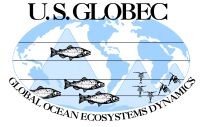August 5, 2002
SeaSOAR continues and the weather holds8:00
a.m.: The weather is holding again today as we prepare to start
our East bound leg toward Gold Beach. This far off the coast, the
water is warm enough for some tuna fishing off the fantail.
.jpg) .jpg) .jpg)
10:30 a.m.: Today's report from Chief Scientist Jack Barth
We have now completed lines 7-9 on the mesoscale
survey and are eastbound
on line 10 (Rogue River line, 42 30'N) with an ETA at the east end of
about 6pm PDT Monday 8/5. That will give us daylight again to
negotiate
the shallow, inshore part of the grid. The winds and seas continue to
be
calm, making for easy operations. We hope to complete the mesoscale
grid
and get back north to the Newport area before winds pick up as
forecast
for the end of the week. We expect to do another "flyby" (HTI
bioacoustics measurements of zooplankton from Revelle compared with
zooplankton net tows from the New Horizon) this afternoon closer
inshore
on line 10.
Sunday evening the bird and mammal observers saw many (~25) humpback
whales around Coquille Bank just north of Cape Blanco. This was an
area
of strong upwelling and high chlorophyll. We expect to cover this
region
again during our south fine-scale survey later in the cruise. We
enjoyed
an excellent view of Port Orford in the twilight before heading back
out
to sea. We could see the smoke from the Illinois Valley fires to the
south.
The bio-optics group (Wingard, Howard, Briggs) flow-through systems
continue to work well. The phytoplankton physiology group (Letelier,
Ashe, Sanders, Corno, Andrades) have
operated the Fast Repetition Rate Fluorometer (FRRF) and MicroSAS
continuously since we sailed. They take discrete samples every 1-2
hours
for chlorophyll, nutrients (frozen for analysis back at OSU), HPLC
pigments, absorption, flow cytometry and particle size distributions.
They have conducted two C14 productivity experiments using surface
offshore waters and will complete a third today using inshore,
upwelled
water. All these measurements are intended to assess the phytoplankton
assemblages and their physiological state.
The physical and biological measurements have shown some amazing
structure
associated with an offshore cyclone (counterclockwise eddy) located at
42 45'N, 125 45' W. This is a piece of coastal water spinning off from
the alongshore coastal upwelling jet. The strong counterclockwise
circulation appears to be forcing cold water, phytoplankton and
zooplankton down from near the surface to over 100 m depth. Given this
striking feature, we hope to return to the eddy region for a day of
intense sampling (SeaSoar/HTI and deep CTD/rosette casts) after we
complete the mesoscale survey on Tuesday night. The New Horizon will
join
us to tow the zooplankton nets through the feature. The goal is to map
the physical structure of this eddy and to determine the contents and
physiological state of the phyto- and zooplankton communities which it
contains.
---Jack Barth, Chief Scientist R/V Roger Revelle
filed 1030 PDT August 5 2002
12:00 p.m.: Activity in the main lab is proceeding on schedule.
Both the bio-optics group and the phytoplankton physiology group
will continue operations while we are completing the mesoscale survey.
Once the mesoscale survey is complete, some of the work will shift as
we move onto some station work and deploy the CTD.
.jpg) .jpg) .jpg) .jpg)
4 p.m.: We made another rendezvous with the New Horizon in very
calm seas. Almost all aboard have been commenting on how
exceptional the weather has been. The conditions enabled
us to view the hundreds of jellyfish in the clear water as we made our
inshore turn. (see video below)
.jpg) .jpg)
Video Clip
August 5, 2002
This clip shows some of the work done by the phytoplankton
physiology group (such as particle size distribution) on water samples they collect every
two hours. |
 Broadband
version Broadband
version
56K version |
Video Clip
August 5, 2002
The sea and wind were very calm this evening near
Gold Beach. Visible in the water were many large jellyfish. |
 Broadband
version Broadband
version
56K version |
Previous update August 4
Next update August 6 |


.jpg)
.jpg)
.jpg)
.jpg)
.jpg)
.jpg)
.jpg)
.jpg)
.jpg)



